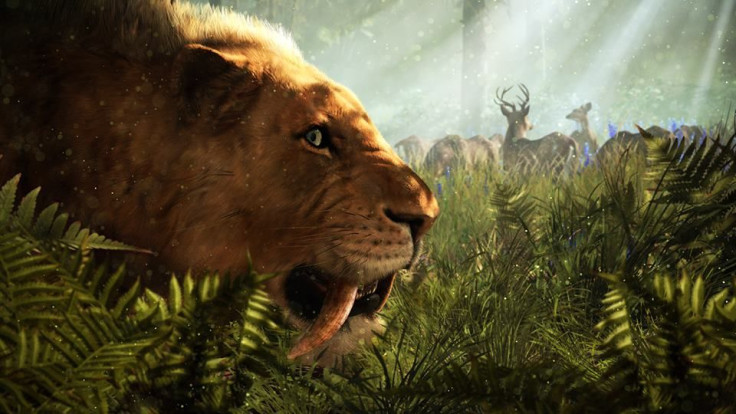Far Cry Primal feels as if it’s meant to entice gamers who are new to open world games. It’s fun without being overwhelming, but too simple to challenge veterans to the genre. Ultimately, you’ll either enjoy or feel indifferent to Far Cry Primal .
You play as Takkar, the new leader of the Wenja. After the rival tribe Udam killed a fellow Wenja tribesman, Takkar is set on exacting revenge. Takkar possesses the unique ability to tame the fiercest of beasts and is able to use his skills to unite the Wenja. It’s very episodic. When you return to Far Cry Primal after logging out it recaps what you play through as if you were tuning into a TV show. You follow Takkar’s hero’s journey and triumph in a brutal world.
The breakdown
Far Cry Primal is melee based, but there’s a strong stealth aspect as well. The first-person controls are simple. There are some missions where you’re forced to take your time and sneak through. Others you can blow your way through with a club. You can easily fall into the “just one more mission” trap and end up playing for hours later. There are forts you can conquer, caves to explore, collectibles and beasts to tame.
Side note: I experience motion sickness when I start playing new first-person games. I played for 30+hours on the PS4 with adjusted camera settings and did not experience nausea or headaches. Kudos to Ubisoft for the excellent camera settings and controls.
Taming beasts is fun. You must be aware of your surroundings and slow with your movements when hunting animals. As you progress the story, you’ll be able to create mixtures that’ll help mask your scent, develop abilities that’ll quiet your step and, the most badass of all, ride some beasts. It’s incredibly satisfying to hop on a Mammoth and crush some Udam. The beasts you tame have their own skill sets that can help you in battle. For example, bears are fearless and difficult to take down. They’re great for wiping out rival tribesman campsites with medium difficulty and higher.
However, you can’t take your tamed beasts with you during certain missions. It’s stupid development decision: What’s the point of having these tamed beasts if you can’t call on them when you need them? It would make sense if you can’t take certain breeds with you because they would draw too much attention, but the animals with high stealth should be allowed to come with you.
Then there’s the crafting system. You don’t have an arsenal of weapons at your disposal, which is the point of the primal era setting. You’ll have a bow, throwing darts, spears and some traps. Finding resources for the items isn’t particularly challenging. You’re introduced to Sayla, the gatherer, in the beginning of the game and the skills she teaches you makes it easy to spot the resources you need.
In general, it’s an overly simplified crafting system. You can’t customize your weapons, only unlock the presets once you gather the needed materials. You can’t poison your arrows or craft a double-edged spear or anything like it. You don’t have to think about what weapons you use. The game does most of the thinking for you and doesn’t give you many options. There was a lot of wasted potential with the crafting system.

Far Cry Primal: How Ubisoft Brought Ancient Languages Back To Life
The map and missions
The map size is big, but the missions are repetitive. You’ll see a lot of icons on the map, but most of them are for campsites, animals and collectibles. You’ll be rewarded for getting collectibles and earn XP for killing animals. However, the campsites takeovers are the most important side quests of all.
Growing your Wenja population helps you earn more resources and XP. There’s a stash bag in all of the campsites you takeover. In the bag, you’ll find resources animal skins, wood, flint, etc. that the Wenja have brought back to your camp. It replenishes once a day. The more Wenja you have, the more resources they’ll find for you. It saves you time when you don’t want to hunt to get things like meat, wood for arrows and animal fat for fires.
There are random events when on the map where you can save Wenja to grow your population. You can choose to ignore them, but they’re easy to beat. Usually it entails killing some Udam and setting some people free or escorting Wenja to a campsite. Unfortunately, there aren’t that many characters to explore in the game, so saving the Wenja doesn’t serve much purpose other than personal gain.
However, you’ll need to progress the main story in order to unlock weapons and skills. There’s no way around it. You have to find the people who can help you unite the Wenja and they will teach you the necessary skills. If you want to play through the “Very Hard” missions, you need to follow the story. You also need to progress the story to unlock missions.

The problems
The problem is the game breaks its own rules at times. In one of the “Very Hard” missions, you have to kill someone from a rival tribe. The rival is well protected, so I stealthily took out as many guards as I could. I thought I had the rival cornered for a one-on-one fight, but then I heard a horn. Reinforcements were called. This is outright confusing and annoying but, most of all, unnecessary.
The issue comes from what you learn when taking over rival camps to grow the Wenja population. There are horns marked in white and gold on your map. White horns are posts any enemy can use to alert their fellow tribesman of danger. The gold horns are tribesmen who carry horns. You can break the white horns and kill the gold horn holders to keep them from calling reinforcements.
The mission I described above had no white or gold horns. There was no way for me to stop the reinforcements from coming to defend the rival. You can’t tell who’s blowing the horn or where the call is coming from. I spent 30 minutes fighting off enemies and trying to find a horn to stop them from respawning before I died. I looked everywhere and didn’t see anything. There was no horn. It’s a cheap way to make a mission more “challenging” and reveals underlying issues with the game. While Far Cry Primal is entertaining, it’s not a very deep open world game.
Most of the missions seem like there’s only one way to get through them. For example, there’s a character named Dah you have to get from an Udam camp. It seems like the game wants you to use your Owl, the first beast you tame in Far Cry Primal. You’re guided to put all of these skills points to train your Owl to attack. If you’re owl can’t attack, you’ll have a difficult time acquiring Dah. You’ll need the Owl to kill the stronger Udam and take out the gold horns that call for reinforcements. You have to stealth your way through that mission, even though Takkar is strong enough at this point to brute his way into the camp with the proper distractions.
The Owl perks are awesome, but you can’t use them to your liking. As I previously stated, you can’t take your tamed beasts with you everywhere. You put all these skills perks into the Owl, but the animal isn’t at your disposal. It doesn’t make any sense.
The big picture
The point of open world games is to allow you to explore the world on your own terms, not dictate the way you play. It only took a few hours to get through the first seven out of the main 13 missions in Far Cry Primal . You’re then forced to grind a bit and put through missions that seem too easy or tedious. While Far Cry Primal is entertaining, I’m not sure it’s enough to make veterans to open-world games want to pick it up.
Editor's note: Takkar's name was misspelled as Jakkar. Correction has been made.


















